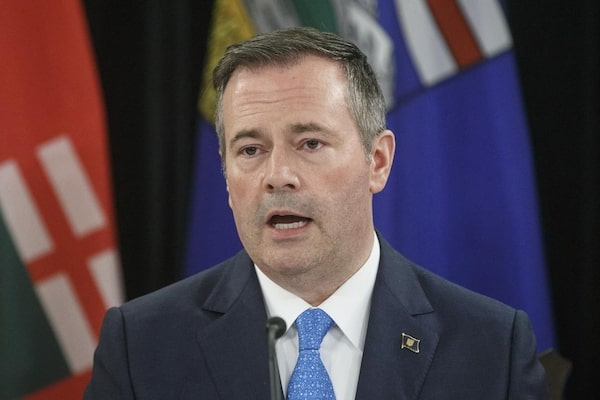
Alberta Premier Jason Kenney in Edmonton on June 27, 2019.The Canadian Press
Alberta’s school boards have yet to receive their budgets from the provincial government, resulting in pre-emptive cuts before students returned to classes this week in case they find out money they once counted on isn’t there.
The province’s parents and students have been warned to expect larger class sizes and fewer resources this year, including fewer educational assistants, therapists and programs such as music because of a level of budgetary uncertainty that many administrators say they haven’t seen in recent years.
Premier Jason Kenney’s United Conservatives have warned that they won’t table a provincial budget until this fall, expected in late October at the earliest. Alberta has not had a full provincial budget since the spring of 2018 because a budget expected earlier this year was pre-empted by the election that brought Mr. Kenney to office.
The new government didn’t provide a full education budget as part of a stop-gap spending bill this summer. Without a concrete spending document from the legislature in Edmonton, school boards across the province have had to make guesses about how much money they will receive and which programs will be funded.
The situation has created difficult decisions for trustees such as Trisha Estabrooks, the board chair of Edmonton Public Schools. “When we passed our budget we had to make a number of assumptions and we’ve had to pass on that uncertainty to our schools. Principals are now grappling with that, which means we don’t know what resources we’ll have when Premier Kenney passes his budget,” she told The Globe and Mail.
The one bright spot for schools has been an assurance from Education Minister Adriana LaGrange that the government will provide more funding to schools that have seen enrolment growth. Edmonton’s public school board added 3,000 more students to the system this year.
However, many school boards are anticipating that a fund meant to shrink class sizes will be gone, while others have cancelled nutrition programs for disadvantaged students assuming that money earmarked for that won’t appear. The result has been hundreds of fewer teaching and support staff positions across the province.
School boards have also warned that if the government does come through with more money in the fall, the damage will largely have been done for this academic year. October or November will be too late to break up classrooms in Calgary or Edmonton bursting with up to 45 students, they say.
The Calgary Board of Education, the city’s public school board, was expecting an additional 1,800 students to walk into schools this week. Despite the higher enrolment, the board’s budget for this year called for cuts and larger class sizes.
Bob Cocking, the head of the association representing Calgary’s public school teachers, said this year’s school board budget is the first he has seen in which the budgets of individual schools have been cut. In the past, the board found ways to trim budgets for technology or facilities, and didn’t axe the funding each school gets.
“We’re playing it safe. The Calgary Board of Education took $22-million out of school budgets, which equates to one fewer teacher in a small elementary school to five or six fewer in high schools. We’re definitely seeing larger class sizes because of that,” he said.
During this first week of classes, principals have been calling parents and letting them know that their children are in classrooms with upwards of 30 students, according to Mr. Cocking. In some classrooms, there are more than 40 students.
Alberta doesn’t have legislated caps on class sizes, but the province’s guidelines call for classes not to exceed 27 students in high school. The average high-school class provincewide in 2017 was 23 students. The province has struggled with large class sizes in recent years, especially between kindergarten and Grade 3. The Education Ministry spent $293-million in 2018 on a program to reduce class sizes. Many administrators worry that program will now be cut.
No funding decisions have yet been made by the provincial government, Colin Aitchison, Ms. LaGrange’s press secretary, said in a statement.
“Minister LaGrange has been clear that the government has committed to funding education and enrolment growth will be accounted for. No funding decisions have been made at this point, and work continues to prepare for the provincial budget in the fall,” he said.
The funding uncertainty has hit more than just schools. The Alberta School Councils’ Association, a parental group that has trained and advised schools across the province for 90 years, is weeks away from running out of money. Allison Pike, the association’s president, says it is considering layoff notices in October and will soon need to ask school boards to start paying for their training sessions, something that has been covered by provincial grant up to now.
“It’ll be a hardship for us if we don’t get funding and it’s difficult not to know and wait until the fall. Without money we would still exist as an association, but we won’t be providing our services,” she said. The group has seen its funding fluctuate, but has not faced this situation in the 90 years it has operated.
The loss of one of the main ways parents communicate with the Education Ministry comes at a time when parents are being asked to step up and start fundraising for programs that could be cut, said Barb Silva with the advocacy group Support our Students.
She warned that students are losing access to a well-rounded education as parents are finding out where cuts have been made.
“We’re already seeing less access to libraries because they aren’t being manned. There are schools now staffed with 0.3 physical-education teachers and 0.2 music teachers. I think there’s more damage to come because school boards have braced themselves for the same funding as last year, but the funding could get worse,” Ms. Silva said.